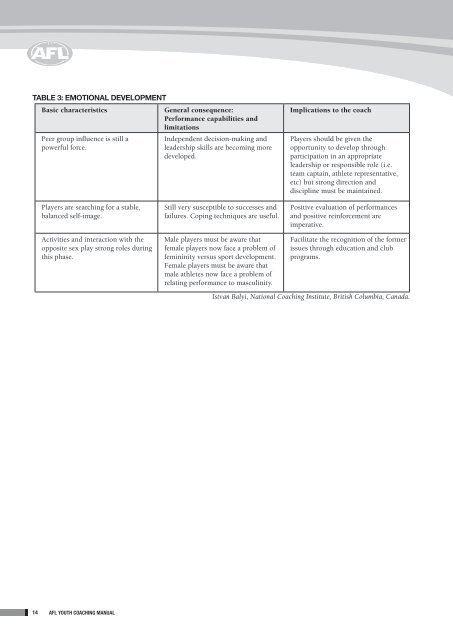2012 Youth Coaching Manual - AFL Community
2012 Youth Coaching Manual - AFL Community
2012 Youth Coaching Manual - AFL Community
You also want an ePaper? Increase the reach of your titles
YUMPU automatically turns print PDFs into web optimized ePapers that Google loves.
Table 3: Emotional development<br />
Basic characteristics<br />
Peer group influence is still a<br />
powerful force.<br />
General consequence:<br />
Performance capabilities and<br />
limitations<br />
Independent decision-making and<br />
leadership skills are becoming more<br />
developed.<br />
Implications to the coach<br />
Players should be given the<br />
opportunity to develop through<br />
participation in an appropriate<br />
leadership or responsible role (i.e.<br />
team captain, athlete representative,<br />
etc) but strong direction and<br />
discipline must be maintained.<br />
Players are searching for a stable,<br />
balanced self-image.<br />
Still very susceptible to successes and<br />
failures. Coping techniques are useful.<br />
Positive evaluation of performances<br />
and positive reinforcement are<br />
imperative.<br />
Activities and interaction with the<br />
opposite sex play strong roles during<br />
this phase.<br />
Male players must be aware that<br />
female players now face a problem of<br />
femininity versus sport development.<br />
Female players must be aware that<br />
male athletes now face a problem of<br />
relating performance to masculinity.<br />
Facilitate the recognition of the former<br />
issues through education and club<br />
programs.<br />
Istvan Balyi, National <strong>Coaching</strong> Institute, British Columbia, Canada.<br />
14 <strong>AFL</strong> <strong>Youth</strong> <strong>Coaching</strong> <strong>Manual</strong>

















